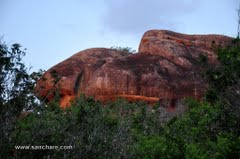 Hidden amidst the Kudumbigala Wildlife Sanctuary and few miles away from the Kudumbigala Forest Hermitage are the remains of an ancient monastery lost to the time and the jungle.
Hidden amidst the Kudumbigala Wildlife Sanctuary and few miles away from the Kudumbigala Forest Hermitage are the remains of an ancient monastery lost to the time and the jungle.
Ruins scattered over nearly 60 acres of jungle speaks volumes of its glory days but nothing moves a devotee other than the 36 feet reclining Buddha statue of Bambaragasthalawa. Built inside a cave, which had protected it from the hardships of nature, the giant statue made out of a mixture of clay and lime had succumbed to the malice of humans, who have dig in its head, feet and mid sections in search of treasure. Today piles of stone, clay and lime dust lay in front of this reclining Buddha witness to a countrywide plunder of a nation’s history and treasure.
 The drip ledged cave, which house the statue of Buddha and Buddha statue itself is believed to have been built between fourth and eighth century yet the history of the monastery starts in the regime of King Gotabhaya who ruled the country in the years of 249-262 A.D. Prominent Archaeologist C.W.Nicholas believes the monastery to be the famed Nagapabbatha monastery of the Southern Kingdom built by King Gotabhaya. This assumption is backed by a stone inscription found at the 200 feet long drip ledged cave found in the monastery. The cave with partitioned interiors and plastered walls carries the inscription, which states that it is named ‘nagapawatha senasana ‘ and was built by a donor called ‘Mithra’. The cave is situated on the edge of a rock precipice, affording a spectacular view around and is believed to be the first cave constructed in this monastery. According to the ancient dhamma cannon ‘Rasavahini’ the cave had been donated to Thissa Maha Naga Thera and had gradually grown into a monastery of grander scale by eighth century.
The drip ledged cave, which house the statue of Buddha and Buddha statue itself is believed to have been built between fourth and eighth century yet the history of the monastery starts in the regime of King Gotabhaya who ruled the country in the years of 249-262 A.D. Prominent Archaeologist C.W.Nicholas believes the monastery to be the famed Nagapabbatha monastery of the Southern Kingdom built by King Gotabhaya. This assumption is backed by a stone inscription found at the 200 feet long drip ledged cave found in the monastery. The cave with partitioned interiors and plastered walls carries the inscription, which states that it is named ‘nagapawatha senasana ‘ and was built by a donor called ‘Mithra’. The cave is situated on the edge of a rock precipice, affording a spectacular view around and is believed to be the first cave constructed in this monastery. According to the ancient dhamma cannon ‘Rasavahini’ the cave had been donated to Thissa Maha Naga Thera and had gradually grown into a monastery of grander scale by eighth century.
Almost all the caves found in the vicinity had been drip ledged, partitioned and decorated into abodes of meditating monks, Some caves running around the rock cliffs and as large as 260 square feet. Walls in the large caves depict brick work decorated with swans while some carpentry work still remains after nearly 1000 years.
 Worshipping halls, preaching halls, alms halls and toilet and bath facilities had been built in rock and bricks and decorated in subtle brick and masonry work and still remain in ruins amidst the monastery grounds, which now does not even have a direct road reachable by feet. Nearly ten stupa had been built on the rock cliffs facing the South-eastern beaches in the fourth century and would have been the white beacons beckoning seafarers of a country, whose land is filled with saffron robed monks and people who follows an age old Dhamma. Yet they lay ruins today, playgrounds to the leopards and bear who haunt a monastery once known as Nagapawatha monastery of the East.
Worshipping halls, preaching halls, alms halls and toilet and bath facilities had been built in rock and bricks and decorated in subtle brick and masonry work and still remain in ruins amidst the monastery grounds, which now does not even have a direct road reachable by feet. Nearly ten stupa had been built on the rock cliffs facing the South-eastern beaches in the fourth century and would have been the white beacons beckoning seafarers of a country, whose land is filled with saffron robed monks and people who follows an age old Dhamma. Yet they lay ruins today, playgrounds to the leopards and bear who haunt a monastery once known as Nagapawatha monastery of the East.

Leave a comment